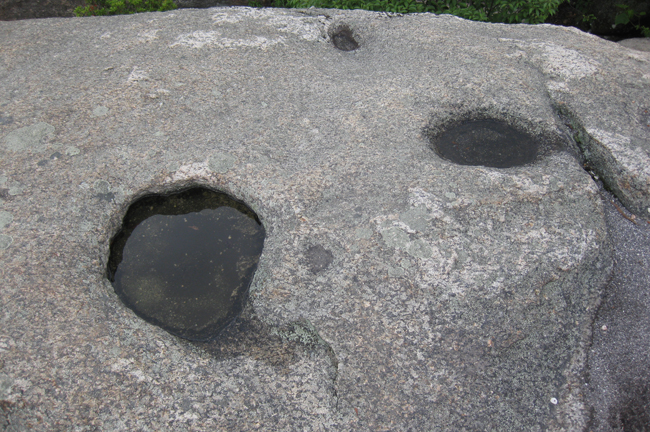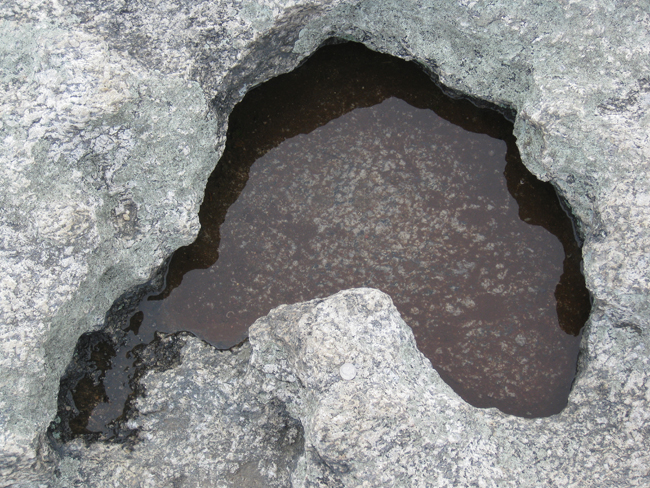17 June 2014
Weathering on Old Rag Mountain 2: Opferkessel
Posted by Callan Bentley
Yesterday, I pointed out an example of differential weathering on Old Rag Mountain, in Shenandoah National Park, in Virginia. Today, I’d like to shine the spotlight on another example of weathering to be seen along the trail there: little weathering pits that occur on the top of the granite outcrops. These are opferkessel.

Some people call these “potholes,” a term I do not approve of in this context. To me, “pothole” implies focused abrasion (in a fluvial setting) – which is not how opferkessel form. Others opt to dub them “solution pans,” but I don’t love that one either, since the granite isn’t really “going into solution” at these sites so much as it is being subjected to increased levels of chemical (and, to a lesser extent, physical) weathering. The actual genesis of opferkessel is more prosaic and basic: the chaotic business of weathering a rock means some areas will be higher than others, and some will be lower. The lower spots tend to hang on to rainwater for longer, which means the minerals lining those low spots will be subjected to more chemical weathering (oxidation and hydrolysis mainly, in the context of granite). Consequently, those minerals “rot” faster than their neighbors in higher, drier positions. When the wet minerals weather away, the little low spot becomes bigger, and so can hold more water, and that can encourage more chemical weathering, and so on. It’s a self-amplifying process. Physical weathering may play a role, too – I can envision additional breakup of the granite due to the splashing action of impacting raindrops, the jostling of small waves, and even the grinding action of ice that forms in the opferkessel during winter months. Many of the opferkessel have living things in them, too, and the humic acids, hyphae, and even scrabbling of little legs may focus additional weathering power on the walls and floor of the opferkessel.
The actual summit (highest point) of the mountain (3,291 feet above sea level) has a very well-developed opferkessel, too:
 (Note the quarter for scale on the “peninsula” at bottom center)
(Note the quarter for scale on the “peninsula” at bottom center)
If you’re into weathering, Old Rag’s an excellent destination.
If you can’t get to Old Rag in person, here’s a GigaPan of an opferkessel there for you to explore:
link


 Callan Bentley is Associate Professor of Geology at Piedmont Virginia Community College in Charlottesville, Virginia. He is a Fellow of the Geological Society of America. For his work on this blog, the National Association of Geoscience Teachers recognized him with the James Shea Award. He has also won the Outstanding Faculty Award from the State Council on Higher Education in Virginia, and the Biggs Award for Excellence in Geoscience Teaching from the Geoscience Education Division of the Geological Society of America. In previous years, Callan served as a contributing editor at EARTH magazine, President of the Geological Society of Washington and President the Geo2YC division of NAGT.
Callan Bentley is Associate Professor of Geology at Piedmont Virginia Community College in Charlottesville, Virginia. He is a Fellow of the Geological Society of America. For his work on this blog, the National Association of Geoscience Teachers recognized him with the James Shea Award. He has also won the Outstanding Faculty Award from the State Council on Higher Education in Virginia, and the Biggs Award for Excellence in Geoscience Teaching from the Geoscience Education Division of the Geological Society of America. In previous years, Callan served as a contributing editor at EARTH magazine, President of the Geological Society of Washington and President the Geo2YC division of NAGT.
Thanks for the lesson. In Southern California, your potholes are often old metate predecessors. The First People used granite outcrops to grind acorns, and over the years holes were developed. I imagine one would tell the difference between metates and potholes by the smoothness of the sides of the depression. In addition, the grouping of the metates would indicate that acorn grinding was a communal affair (although I’ve seen single metates on occasion.)
Hi Callan,
I was thinking about these cool “pots” on top of Old Rag to show my class and my search yielded You! So cool. Good to see you engaged in something you love.
Peter
now a teacher at elementary school in Alexandria, Virginia.
If this reaches you and you have a second, say Hi.
Best,
Peter